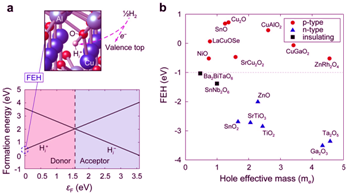 Computational discovery of p-type transparent oxide semiconductors using hydrogen descriptor (采用氢描述子计算发现p型透明氧化物半导体)
Computational discovery of p-type transparent oxide semiconductors using hydrogen descriptor (采用氢描述子计算发现p型透明氧化物半导体)
Kanghoon Yim, Yong Youn, Miso Lee, Dongsun Yoo, Joohee Lee, Sung Haeng Cho & Seungwu Han
npj Computational Materials 4:17 (2018)
doi:10.1038/s41524-018-0073-z
Published online:03 April 2018
Abstract| Full Text | PDF OPEN
摘要:终端透明电子器件需要互补且对称的n型和p型透明半导体对。虽然已经有几种n型透明氧化物半导体(如InGaZnO和ZnO)用于消费电子产品,但目前科学家们还未找到可与对应的n型半导体相媲美的p型氧化物。最近,利用密度泛函理论计算的高通量筛选法,研究者尝试着筛选出几种p型透明氧化物,但这些候选材料没有得到有效的实验验证,这意味着尚需更好的理论预测因子。本研究提出了一种高可靠性和高计算效率的p型掺杂因子——氢杂质能级。并验证了采用氢掺杂因子可以区分众所周知的p型和n型氧化物。使用氢掺杂因子,作者筛选了大多数二元氧化物和一系列三元化合物,它们涵盖了含Sn2+和含Cu1+的氧化物以及氧硫族元素化合物。依据筛选结果,本研究提出了两种富有前景的p型氧化物:La2O2Te和CuLiO。
Abstract:The ultimate transparent electronic devices require complementary and symmetrical pairs of n-type and p-type transparent semiconductors. While several n-type transparent oxide semiconductors like InGaZnO and ZnO are available and being used in consumer electronics, there are practically no p-type oxides that are comparable to the n-type counterpart in spite of tremendous efforts to discover them. Recently, high-throughput screening with the density functional theory calculations attempted to identify candidate p-type transparent oxides, but none of suggested materials was verified experimentally, implying need for a better theoretical predictor. Here, we propose a highly reliable and computationally efficient descriptor for p-type dopability—the hydrogen impurity energy.We show that the hydrogen descriptor can distinguish well-known p-type and n-type oxides.Using the hydrogen descriptor, we screen most binary oxides and a selected pool of ternary compounds that covers Sn2+-bearing and Cu1+-bearing oxides as well as oxychalcogenides.As a result, we suggest La2O2Te and CuLiO as promising p-type oxides.
Editorial Summary
Transparent oxides: p-type hunting (透明氧化物:探寻p型半导体)
该研究通过计算特定缺陷的形成能来筛选透明氧化物半导体,并揭示了一些很有前途的空穴掺杂候选对象。尽管p掺杂半导体可用于电子器件,但迄今为止它们的性能与其对应的n型半导体还相差甚远:大多数p型氧化物存在稳定性或透明度差的问题。现在,首尔大学和韩国大田电子与电信研究院的研究团队,通过计算来搜寻具有高导电性和良好透明度的p-掺杂氧化物。他们采用缺陷化学进行筛选,并用氢间隙缺陷的形成能和空穴质量进行估测,以此评定材料的掺杂能力。作者提出了一些有前途的p型二元氧化物和三元化合物,一旦它们的性能被实验所验证,将会在电子器件中发挥巨大的作用。
Computational studies screen transparent oxide semiconductors based on the formation energy of a particular defect, and reveal promising hole-doped candidates. Although p-doped semiconductors are useful for electronic devices, their performance so far is not comparable to their n-type counterparts: most p-type oxides have stability issues or suffer from poor transparency.Now a team from Seoul National University and the Electronics and Telecommunications Research Institute in Daejeon, South Korea, are computationally looking for p-doped oxides with high conductivity and good transparency, simultaneously. Their screening relies on defect chemistry and assesses the dopability of the materials by using the formation energy of hydrogen interstitial defect, as well as the evaluation of the hole mass.Authors put forth a few promising p-type binary oxides and ternary compounds, which can be very useful for implementing electronic devices, once their properties have been verified experimentally.


 沪公网安备 31010502006565号
沪公网安备 31010502006565号